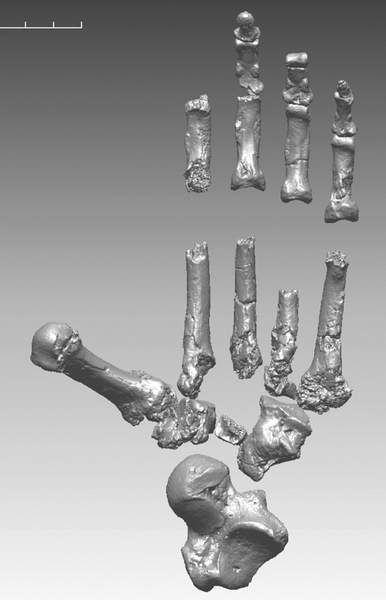Skeleton takes humankind back another 1 million years
Published 5:00 am Friday, October 2, 2009

- This undated, digitally rendered composite image shows the foot of the Ardi partial skeleton.
Lucy, meet Ardi.
Ardi, short for Ardipithecus ramidus, is the newest fossil skeleton out of Africa to take its place in the gallery of human origins. At an age of 4.4 million years, it lived well before and was much more primitive than the famous 3.2-million-year-old Lucy, of the species Australopithecus afarensis.
Trending
Since finding fragments of the older hominid in 1992, an international team of scientists has been searching for more specimens and on Thursday presented a fairly complete skeleton and their first full analysis. By replacing Lucy as the earliest known skeleton from the human branch of the primate family tree, the scientists said, Ardi opened a window to “the early evolutionary steps that our ancestors took after we diverged from our common ancestor with chimpanzees.”
The older hominid was already so different from chimps that it suggested “no modern ape is a realistic proxy for characterizing early hominid evolution,” they wrote.
The Ardipithecus specimen, an adult female, probably stood 4 feet tall and weighed about 120 pounds, almost a foot taller and twice the weight of Lucy. Its brain was no larger than a modern chimp’s. It retained an agility for tree-climbing but walked upright on two legs, a transforming innovation in hominids, though not as efficiently as Lucy’s kin.
Ardi’s feet had yet to develop the archlike structure that came later with Lucy and on to humans. The hands were more like those of extinct apes. And its very long arms and short legs resembled the proportions of extinct apes, or even monkeys.
Human lineage
Tim White of the University of California, Berkeley, a leader of the team, said in an interview this week that the genus Ardipithecus appeared to resolve many uncertainties about “the initial stage of evolutionary adaptation” after the hominid lineage split from that of the chimpanzees. No fossil trace of the last common ancestor, which lived some time before 6 million years ago, according to genetic studies, has yet come to light.
Trending
The other two significant stages occurred with the rise of Australopithecus, which lived from about 4 million to 1 million years ago, and then the emergence of Homo, our own genus, before 2 million years ago. The ancestral relationship of Ardipithecus to Australopithecus has not been determined, but Lucy’s Australopithecine kin are generally recognized as the ancestral group from which Homo evolved.
Scientists not involved in the new research hailed its importance, placing the Ardi skeleton on a pedestal alongside notable figures of hominid evolution like Lucy and the 1.6-million-year-old Turkana Boy from Kenya, an almost complete specimen of Homo erectus with anatomy remarkably similar to modern Homo sapiens.
David Pilbeam, a professor of human evolution at Harvard University who had no role in the discovery, said in an e-mail that the Ardi skeleton represented “a genus plausibly ancestral to Australopithecus” and began “to fill in the temporal and structural ‘space’ between the apelike common ancestor and Australopithecus.”
Andrew Hill, a paleoanthropologist at Yale University also not on the team, noted that White had kept “this skeleton in his closet for the last 15 years or so, but I think it has been worth the wait.”
The first studies
The first comprehensive reports describing the skeleton and related findings, the result of 17 years of study, are being published today in the journal Science. Eleven papers by 47 authors from 10 countries describe the analysis of more than 110 Ardipithecus specimens from at least 36 individuals, including Ardi.
The paleoanthropologists wrote in one of the articles that Ardipithecus was “so rife with anatomical surprises that no one could have imagined it without direct fossil evidence.”
A bounty of animal and plant material — “every seed, every piece of fossil wood, every scrap of bone,” White said — was gathered to set the scene of the cooler, more humid woodland habitat in which these hominids had lived.
This was one of the first surprises, said Giday WoldeGabriel, a geologist at Los Alamos National Laboratory, because it upset the hypothesis that upright walking had evolved as an adaptation to life on grassy savanna.
The discovery site, on what is now an arid floodplain along the middle stretch of the Awash River in Ethiopia, is 140 miles northeast of Addis Ababa and 45 miles south of Hadar, where Lucy was found in 1974 by Donald Johanson, with whom White collaborated in analyzing those fossils.
White, Berhane Asfaw of the Rift Valley Research Service in Ethiopia and other team members concluded that “despite the genetic similarities of living humans and chimpanzees, the ancestor we last shared probably differed substantially from any extant African ape.”
As Hill of Yale said, “It is always new specimens, particularly those from little known time periods or geographic areas, that provoke the greatest changes in our ideas.”
Looking ahead, White lamented that there were so few sites in Africa known to have fossil deposits 6 million to 7 million years old. “We are getting so close to that common ancestor of hominids and chimps, and we’d love to find an earlier skeleton,” he said.








